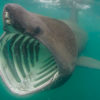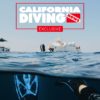A few years ago Sami Laine and Chuck Tribolet were looking for Local’s Ledge off Cypress Point when a high profile ridge popped off the bottom on their depth finder. Like all good explorers they chose to dive the ridge instead of the ledge. It turned out to be such a spectacular site that Chuck named the ridge after his boat–Black Dog Ridge.
Black Dog Ridge runs approximately northeast to southwest, and the ridge is shaped roughly like the keel of a sailboat–long, narrow and steep-sided. This is a small site, about 150 feet long and may be easily explored on a single tank.
Frankly though, when you first drop onto Black Dog Ridge, it does not look like much of a dive site. The ridge top is found at 60 feet and is covered by a by a thin growth of palm kelp. Beneath the palm kelp may be found a bit of low profile encrusting invertebrates. As you drop over the top of the ridge and descend along one of the rock walls, a completely new dive site is revealed.
The most interesting part of the dive is the south-facing wall from 75 down to about 90 feet. Here you will find some of the largest, oldest and most pristine pink and purple hydrocoral in Central California. No little trees here, they are all big and stout. The south wall sports intense color and texture, and is exceptionally photogenic.
Look for little slipper snails among the branches of the hydrocoral. These are parasites that feed on coral polyps, but they are very difficult to find since they develop the same color as the coral they are feeding on. You should also look for an assortment of small fish such as greenlings and small crabs hiding among the branches of the hydrocoral. These trees are so large that it is possible for some rather large fish to take shelter here.
The rock walls are not smooth and have numerous shelves and deep cracks. Look for lingcod sitting on the shelves. These are ambush predators, and spend most of the day waiting for some unsuspecting crab, octopus or rockfish to venture too close. There were quite a few lings on my recent dive. While most were about two feet, one approached four feet long.
The north side of the ridge does not have as much hydrocoral as the south side, but tends to have more fish. There were gopher and black and yellow rockfish in the cracks, and there seemed to be more lingcod there. Patches of strawberry anemones and sponges fill in the gaps between the hydrocoral trees. There were also some nice big anemones, bryozoans, and other colorful invertebrates, but this site is mostly about the hydrocoral.
Black Dog Ridge is close to Cypress Point and is very exposed to wind and swell from any direction; it may only be dived on the calmest of days. So pick your day to dive here very carefully. There are no good lineups, thus you will need GPS to find the ridge. Monterey’s charter boats know this site, but only occasionally dive here. If conditions are right, you may have to request this site. I suspect you and the other divers will not be disappointed.
Location: You will need GPS to this site; it is a bit south and offshore of Cypress Point at 36° 34.381′ N, 121° 58.840′ W. However, do not anchor there to protect the hydrocoral. Instead, anchor off the southwest end of the ridge at 36° 34.371′ N, 121° 58.842′ W; or in the sand on the east side of the ridge at 36° 34.381′ N, 121° 58.807′ W.
Access: Boat only.
Depths: 60 to 105 feet.
Skill Level: This is an advanced dive due to depths and exposure.
Photography: Great photography for invertebrates and reef fish. Great wide-angle photography for hydrocoral and reef scenes.
Hunting: This site is outside of the Marine Protected Areas and hunting is permitted. Since there are so few fish of legal size, I suggest hunting elsewhere.
Hazards: Divers should watch for swell, currents, and boat traffic.







